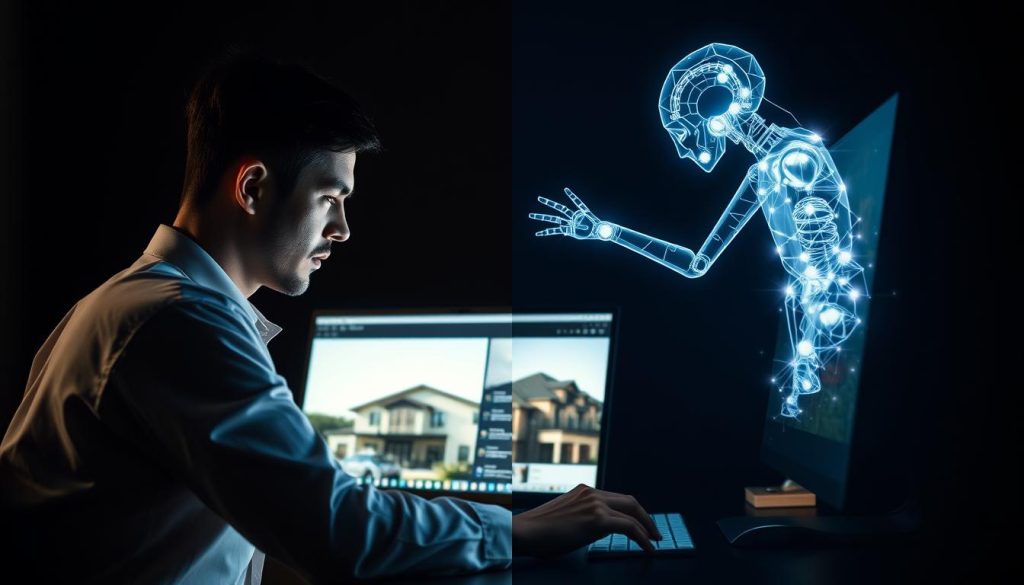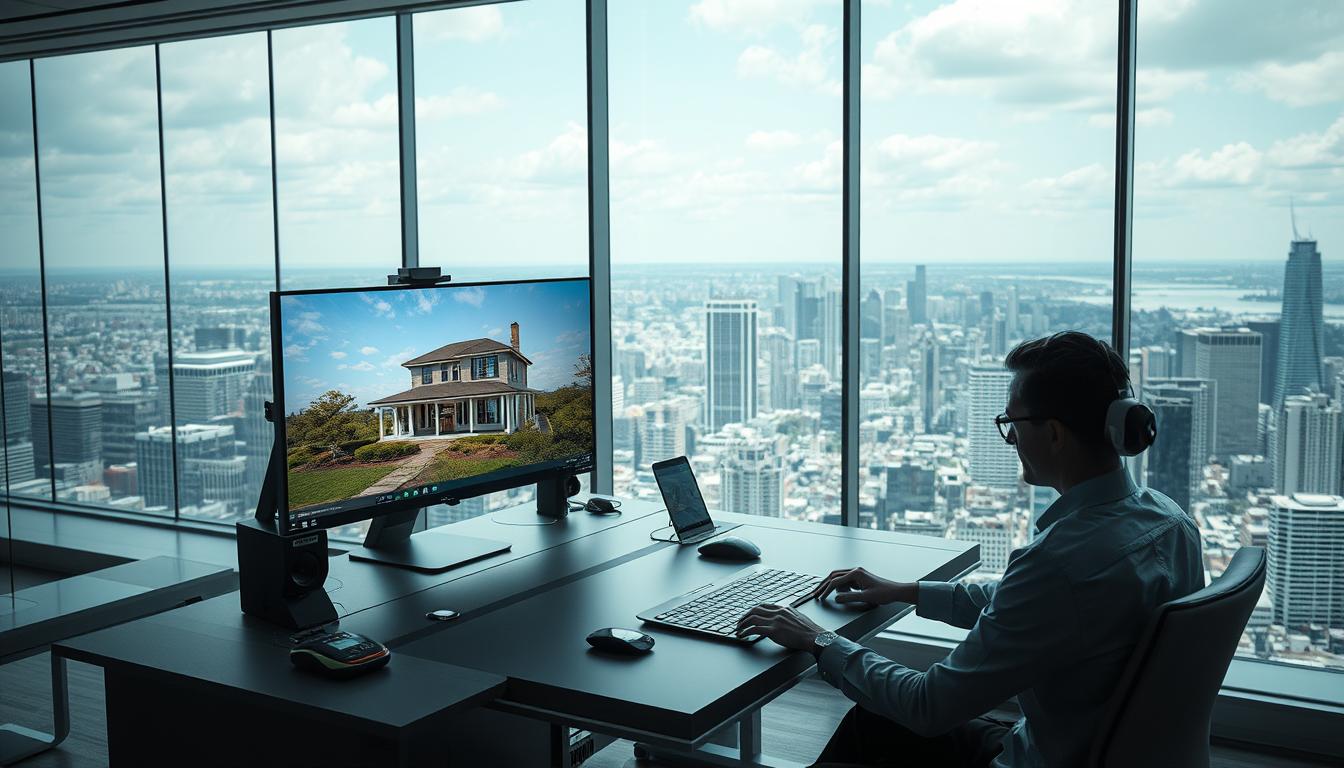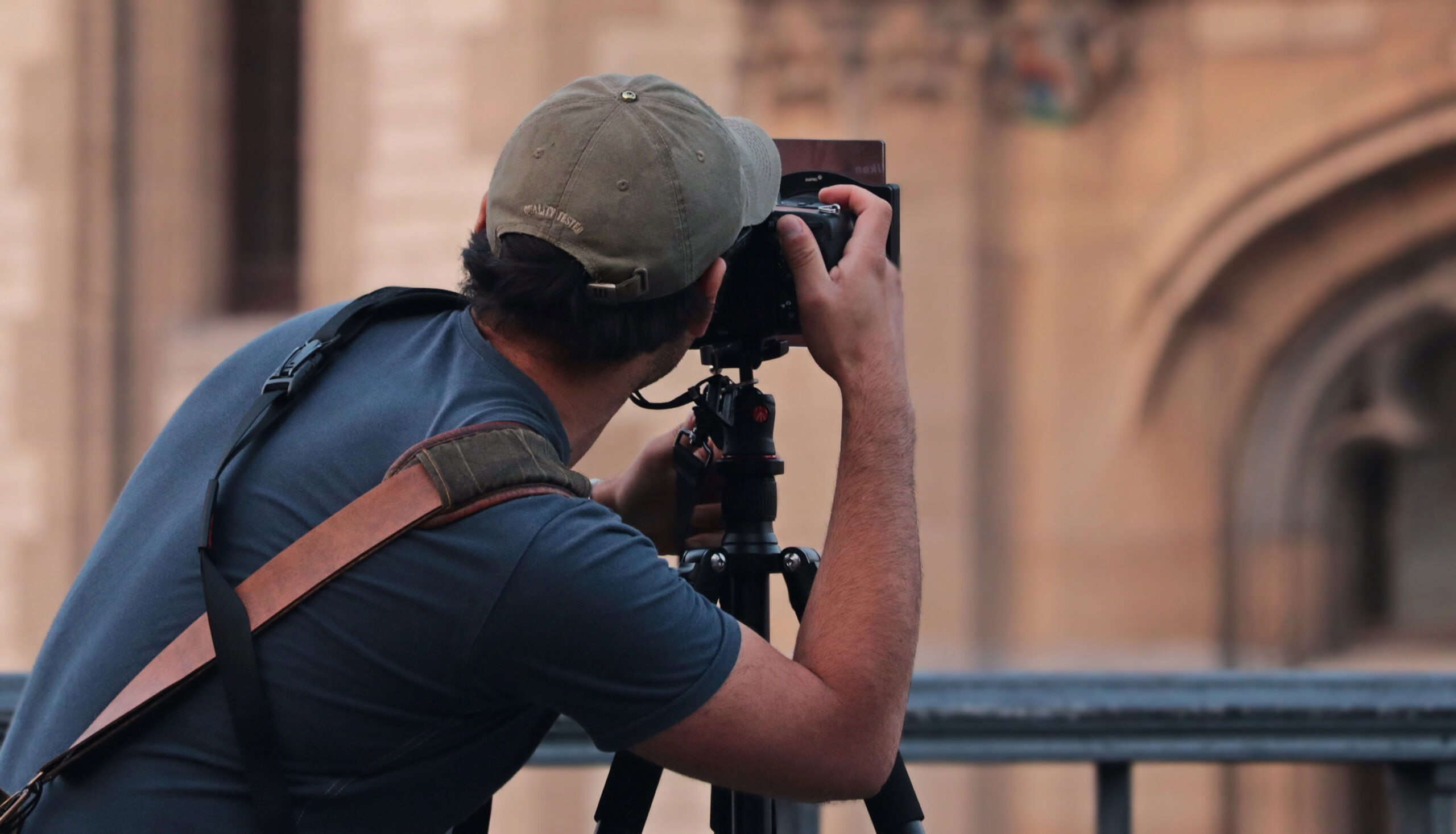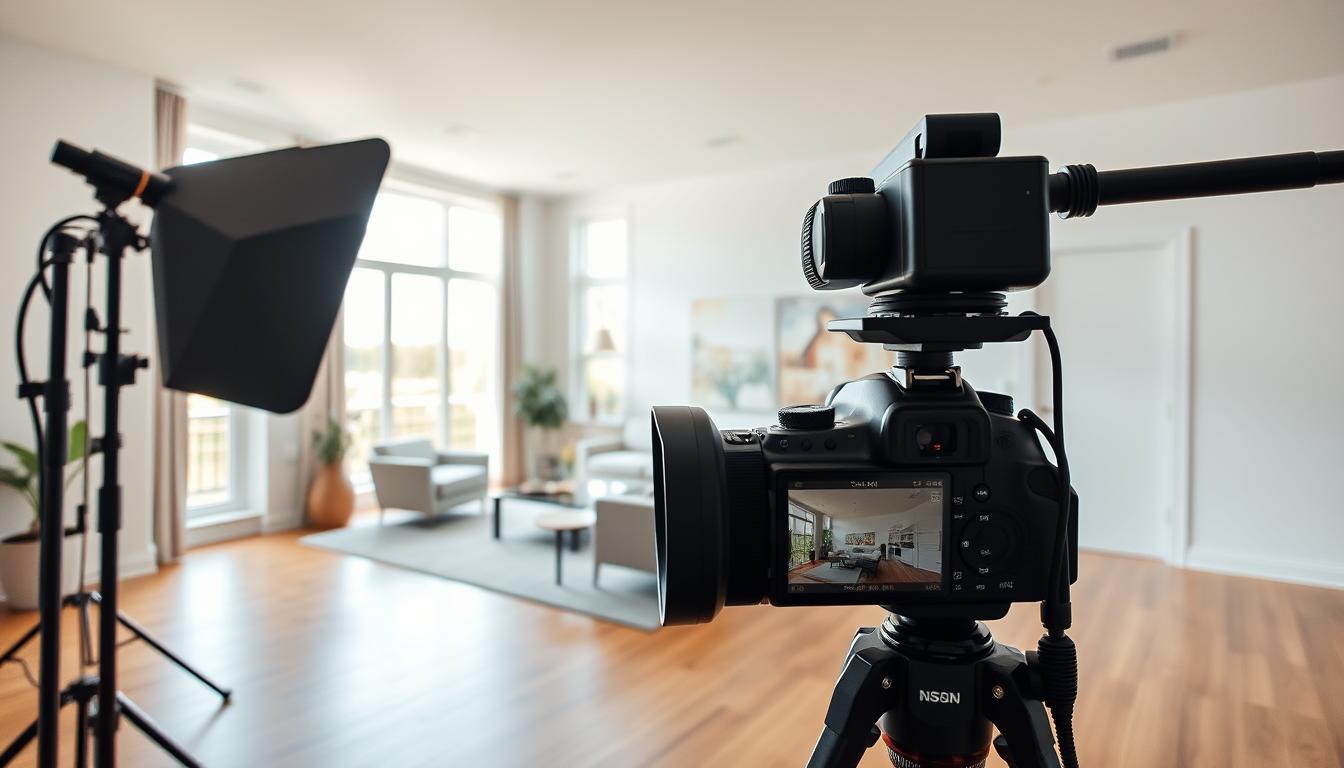The rise of AI in real estate has changed how we market properties online. Good property pictures are key to drawing in buyers. So, photo editing technology is very important in this field.
With more people wanting nice-looking listings, we wonder: can AI do it all? AI has come a long way, but humans are needed for detailed editing.
Key Takeaways
- The importance of high-quality property images in real estate marketing.
- The role of AI in making photo editing faster.
- AI can’t replace humans for tricky editing tasks.
- More people want listings that look good.
- AI and humans might work together more in photo editing.
The Evolution of Real Estate Photography
Real estate photography has changed a lot over time. New tech and what buyers want have driven these changes. Now, how we show properties is better and more detailed.
From Film to Digital: A Brief History
Real estate photography started with film cameras. These needed film to be developed. Then, digital cameras came along. They let us see photos right away and fix mistakes easily.
The Rise of Photo Editing in Property Marketing
With digital cameras, editing photos became key. Now, we use tools to make photos brighter, colors better, and even add virtual scenes. This makes properties look their best.
The Impact on Buyer Expectations
Good photos really matter to buyers. They draw in more people and make the property seem more valuable. Here’s how photos have changed what buyers expect:
| Era | Photography Technology | Buyer Expectations |
|---|---|---|
| Film Era | Film Cameras | Basic property visuals |
| Early Digital | Basic Digital Cameras | Clear property images |
| Modern Era | Advanced Digital Cameras & Editing | High-quality, staged property visuals |
Today, real estate photography is all about quality. It’s about showing properties in the best way possible. This meets the high standards of today’s buyers.
Understanding the Role of Professional Real Estate Photo Editors
In the world of real estate, photo editors are key. They make properties look great. Good photos help buyers decide, making their job very important.
Key Editing Techniques in Real Estate Photography
Editors use many ways to improve photos. They adjust brightness and contrast. They also do virtual staging and object removal. This makes properties look good and real.
Why Quality Editing Matters in Property Sales
Good editing makes a property look better. This can lead to quicker sales and higher prices.
The Connection Between Image Quality and Selling Price
Studies show that great photos get more buyers. A real estate expert said,
“Properties listed with high-quality photos sell for up to 10% more than those with poorly edited images.”
This shows how important image quality is for selling.
Using professional photo editors helps sellers. They know how to make properties look their best. This attracts more buyers.
The AI Revolution in Photo Editing
The AI revolution is changing photo editing. It makes editing faster and better. This new tech is also making the final photos look amazing.
How AI Photo Editing Technology Works
AI photo editing uses special algorithms. These algorithms look at lots of pictures. They learn and get better over time, just like people do.
Recent Advancements in AI Image Processing
Recently, AI image processing has gotten a lot better. Machine learning models are key. They help with things like removing objects and changing skies.
Machine Learning Models in Photography
Machine learning is used a lot in photography now. It helps with editing tasks. For example, it can fix lighting and colors in pictures.
Thanks to AI technology, editing photos is easier. Software can do things that used to take a lot of time. Now, anyone can make photos look great.
Current Capabilities of AI in Real Estate Photo Editing
AI is changing the real estate photo editing world. It uses advanced tech to make property pictures look better. This makes them more attractive to people who might buy them.
Automated Enhancements and Corrections
AI tools can change brightness, contrast, and color in photos. This automated editing saves time. It also makes sure all photos look the same.
Virtual Staging and Object Removal
AI lets you add digital furniture to empty spaces. This helps buyers see how the space could look. It can also remove things you don’t want in the photo. This makes the property look cleaner and more appealing.
Sky Replacement and HDR Processing
AI can swap dull skies for brighter ones. This makes the property look more inviting. It can also mix different light levels into one photo. This creates a balanced image.
Batch Processing Capabilities
AI can edit many photos at once. This batch processing is great for agents with lots of listings. It saves a lot of time.
| AI Capability | Benefit |
|---|---|
| Automated Enhancements | Saves time, ensures consistency |
| Virtual Staging | Helps buyers visualize the space |
| HDR Processing | Balances lighting in images |
The Human Touch: What Professional Real Estate Photo Editors Bring to the Table
Professional real estate photo editors mix technical skills with artistic judgment. They know what makes a property look good. This is something AI systems can’t do yet.
Artistic Vision and Aesthetic Judgment
Human editors have an artistic vision. They know how to use lighting, composition, and color. This makes a property look amazing.
A top real estate photography expert said, “The difference between a good photo and a great one is the editor’s touch. They make the image look natural and enhanced at the same time.”
Complex Problem-Solving in Challenging Images
Editing property photos isn’t always easy. Human editors are great at complex problem-solving. They fix issues like bad lighting and clutter.
They use their creativity to make the images look great.
“The human eye can detect subtleties in an image that AI might miss, allowing for a more nuanced editing approach.”
Understanding Client Needs and Market Expectations
Professional real estate photo editors understand client needs and market expectations. They adjust their editing to fit different properties and audiences. This ensures the images meet the client’s goals and attract buyers.
Human real estate photo editors offer quality and customization. This is something AI can’t match yet.
AI vs. Human Real Estate Photo Editors: A Side-by-Side Comparison
In real estate photography, AI and human editors are compared. This helps us see where each is best and where they might not be.

Speed and Efficiency Analysis
AI photo editors are way faster. They can edit images in seconds, which is great for many properties. But, human editors can’t keep up with AI’s speed.
Yet, AI might struggle with tricky edits that need a human’s eye.
Quality and Consistency Evaluation
Human editors have an artistic touch that AI doesn’t. They make edits that fit the client’s style and what buyers want. AI has gotten better, but it’s not always consistent.
As one expert said,
“AI can do amazing things, but it misses the human touch in seeing a property’s true charm.”
Handling Edge Cases and Unusual Properties
Human editors are great with special cases and unique properties. They use their creativity and problem-solving skills. AI might find it hard to handle these, leading to wrong pictures.
But, AI can get better with more training.
AI is fast and efficient, but human editors are better at quality and dealing with tough cases. Maybe the best thing is to use both AI and human editors together.
Cost Considerations: AI Tools vs. Professional Editing Services
The debate between AI and human editors in real estate photography is about cost and return on investment (ROI). Real estate professionals want to save money. They need to know the cost difference between AI and human photo editing.
Pricing Models for AI Photo Editing Platforms
AI photo editing platforms have subscription or pay-per-use plans. Some AI tools charge $0.50 to $5 per image. This depends on how complex the edits are.
Subscription plans cost $50 to $500 a month. This depends on how many images you need edited and what features you need.
| Pricing Model | Cost Range | Best For |
|---|---|---|
| Pay-per-use | $0.50 – $5 per image | Low to medium volume editing |
| Subscription-based | $50 – $500 per month | High volume editing or businesses with consistent needs |
ROI Analysis for Real Estate Professionals
Real estate pros must think about ROI when choosing AI or human editing. They should look at costs, sales, and customer happiness. AI can make editing faster, which means quicker listings and happier customers.
Long-term Investment Perspective
AI editing is good for growing businesses because it’s scalable and consistent. But, you need to think about the cost of AI tools and if you’ll need human help.
Industry expert says,
“The key to maximizing ROI with AI editing is understanding your business needs and choosing a solution that scales with your growth.”
This shows why it’s important to plan carefully when choosing between AI and human editing.
In conclusion, picking between AI and human editing for real estate photos is a big decision. It’s about costs, ROI, and your business goals. Knowing the prices and what you can get back helps real estate pros make the best choice for their business.
Real-World Applications: Where AI Excels in Real Estate Photography
Real estate photography is changing fast with AI. It’s great for handling lots of photos at once. This helps real estate pros a lot.
High-Volume Property Listings
Real estate agents with many properties find AI very helpful. It can edit lots of photos quickly. This saves a lot of time and effort.
Basic Enhancement and Correction Workflows
AI is good at simple photo fixes like making colors right and removing noise. These small changes make photos look better without a lot of work.
Integration with MLS and Property Listing Platforms
AI works well with MLS and other platforms for listing properties. It lets agents share great photos online easily. This makes properties look better online.
A big real estate company can edit many photos at once with AI. This makes all their listings look the same. Studies show using AI can increase listing views by 30%.
| Feature | Manual Editing | AI Editing |
|---|---|---|
| Time Taken | Several hours | Under an hour |
| Cost | Higher | Lower |
| Consistency | Variable | High |
In short, AI is changing real estate photography a lot. It helps with lots of photos and simple edits. As AI gets better, working with MLS and other platforms will get easier.
When Human Real Estate Photo Editors Are Irreplaceable
In high-stakes real estate markets, human photo editors shine. They bring a special touch to properties and marketing. This touch is hard for AI to match.
Luxury Properties and High-End Marketing
Luxury properties need editing that AI can’t do. Human editors make these properties look their best. They ensure the images show off the property’s luxury.
- Attention to detail in architectural features
- Enhancement of high-end finishes and materials
- Creation of a consistent, high-end aesthetic throughout the property listing

Complex Editing Requirements and Custom Requests
Some properties have unique editing needs. Human editors are best for these tasks. They can remove unwanted objects or stage a property virtually.
Examples include:
- Removing large objects or structures
- Virtually staging empty or cluttered properties
- Creating virtual tours that require precise editing
Building Relationships with Agents and Brokers
Human editors can connect with agents and brokers. They understand what these professionals need. This connection helps in making property marketing better.
Ethical and Regulatory Considerations in AI Photo Editing
AI is changing how we edit photos in real estate. We need to think about ethics and rules. It’s important to stop AI from lying in property ads.
Disclosure Requirements for Edited Images
Should we tell buyers when photos are edited? Real estate folks must decide. It’s a big question.
Avoiding Misrepresentation in Property Marketing
AI can make photos look better, but we must be honest. Over-editing can make things look too good. This can lead to legal trouble.
State-Specific Guidelines in the US
In the US, rules for property ads vary by state. Some states say you must tell buyers about photo changes.
| State | Disclosure Requirement |
|---|---|
| California | Mandatory disclosure for major renovations |
| New York | Recommended disclosure for all edits |
The Hybrid Approach: Combining AI and Human Expertise
The hybrid approach mixes AI’s speed with human touch. It’s changing how we edit real estate photos. This blend uses AI’s power and human skill to make top-notch images.
Workflow Integration Strategies
Using a hybrid approach needs a smart plan. Real estate pros can start with AI for basic edits. Then, humans handle the tricky stuff like adding virtual scenes and removing objects. This way, work gets done fast and well.
Maximizing Efficiency While Maintaining Quality
The secret to a great hybrid approach is doing more with less. AI does simple edits, freeing humans for creative work. This teamwork means faster, better photos.
| Task | AI Role | Human Role |
|---|---|---|
| Basic Edits | Automated adjustments | Quality check |
| Virtual Staging | Initial placement | Final arrangement |
| Object Removal | Detection | Manual refinement |
Case Studies of Successful Implementation
Many real estate firms have seen big wins with the hybrid method. A top firm boosted listing speed by 30%. Another agency made clients happier by mixing AI’s start with human flair for the finish.
Conclusion: Finding the Right Balance for Your Real Estate Photography Needs
Whether AI can replace human photo editors is a big question. AI has improved photo editing a lot. It’s fast and efficient. But, human editors add a special touch and really get what clients want.
For real estate photos, mixing AI and human editors is best. AI is great for many photos and simple edits. But, for fancy homes and complex edits, humans are the best.
Using both AI and human skills is a smart idea. This way, real estate folks can work faster and keep photos looking great. As the real estate world changes, this mix will help them stay ahead.
Knowing what you need for your photos and using the right tools is key. This way, your photos will grab attention and help sell homes.
FAQ
What is the role of AI in real estate photo editing?
AI helps with tasks like making photos better, removing objects, and changing skies. It makes editing faster and more efficient.
Can AI fully replace human real estate photo editors?
AI has come a long way in photo editing. But, it can’t do everything a human can. It’s best for simple tasks, not complex ones.
What are the benefits of using AI in real estate photo editing?
AI makes editing quicker and more consistent. It’s great for handling lots of photos and basic edits.
How does AI photo editing technology work?
AI uses smart models to edit photos. It follows rules to make images better and correct mistakes.
What are the cost considerations for using AI tools versus professional editing services?
Costs include what AI tools charge and what human editors cost. Thinking about long-term savings helps decide what’s best.
How can AI be integrated with MLS and property listing platforms?
AI can make editing easier with MLS and listing sites. It improves photo quality and makes listings look better.
What are the ethical considerations for using AI in photo editing?
Ethics include telling the truth about edited photos. It’s important to avoid lying in marketing. Laws in the US also matter.
Can a hybrid approach combining AI and human expertise be effective in real estate photo editing?
Yes, mixing AI with human skills works well. It balances speed with quality, fitting different needs.
What are the advantages of using professional human real estate photo editors?
Humans add creativity and solve tough problems. They understand what clients want and what the market expects. They’re key for luxury and complex projects.





